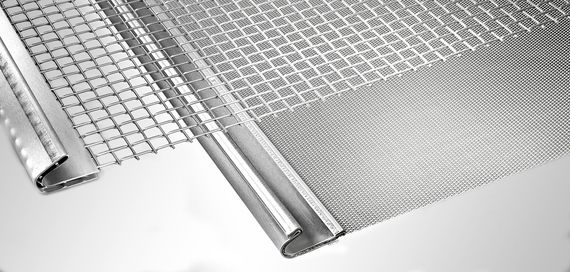Wire Mesh Dewatering Screen Specifications: What Is Right for Me?
Dewatering is a critical step in aggregate processing. It calls for the use of accurate screening equipment to remove water from freshly washed or mined sediment while retaining the material to form a filter cake.
Woven wire mesh dewatering screens are often used as they allow for offer a desirable balance of durability and throughput. But just as with any screening media, their performance is dedicated to selecting the right set of specifications.
Odds are you are probably looking into what you need to implement dewatering screens into your process and are left questioning what specifications are right for you.
W.S. Tyler has been a prominent supplier of woven wire mesh for over 150, helping customers across dozens of industries implement the versatile material along the way. We strive to learn their operation and pain points inside and out in an effort to point them toward solutions that work and drive profits.
And with that, this article was written to establish the mesh specifications you need to keep in mind when designing a woven wire mesh dewatering screen. It will cover:
- What a wire mesh dewatering screen is
- The specifications that make up a wire mesh dewatering screen
- How to select specifications that work
What Is a Woven Wire Mesh Dewatering Screen?
Woven wire mesh is a metallic screening cloth comprised of individual wires that become interwoven after a centuries-old weaving process. A dewatering screen is a screening device designed to perform efficient solid-liquid separation.
When using woven wire mesh as the designated screening media, dewatering screens have the ability to screen particles within a range of 4 mesh to 325 mesh. To that end, they are often employed to drain the water that is used to wash or mine various forms of sediments, such as sand or coal.
What Specifications Should I Be Mindful of When Designing a Woven Wire Mesh Dewatering Screen?
There are three primary specifications that you should be taking into consideration when designing your wire mesh dewatering screens. These specifications are weave type, panel dimension, and hook type.
Weave Type
The wire mesh layers in a W.S. Tyler dewatering screen can be woven following one of three weave patterns: square mesh, TY-ROD, and TON-CAP. Each pattern was designed to deliver a specific set of benefits that will help you create a tailored solution.
Square Mesh
Square mesh is a standard weave type that uses a simple over-under weave style. It is known for its tight tolerances and precise mesh openings.
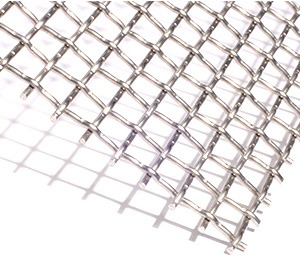 With this over-under style, many variations of the weave type can be achieved. For example, two warp wires can go over the single weft wire. This can help enhance the rigidity of the weave while also controlling the size of the mesh openings.
With this over-under style, many variations of the weave type can be achieved. For example, two warp wires can go over the single weft wire. This can help enhance the rigidity of the weave while also controlling the size of the mesh openings.
TY-ROD
TY-ROD is a weave type designed to minimize blinding. This is accomplished by weaving the wires to feature slotted openings larger than those of the TON-CAP weave.
These slotted openings can be woven to lengths up to 2”.
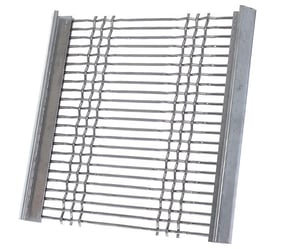 Not only do these elongated slotted openings prevent blinding, they work to deliver superior throughput. Furthermore, the characteristics of TY-ROD can minimize cleaning time.
Not only do these elongated slotted openings prevent blinding, they work to deliver superior throughput. Furthermore, the characteristics of TY-ROD can minimize cleaning time.
TON-CAP
TON-CAP is a weave type that, like TY-ROD, is woven to feature slotted openings. This unique weave allows you to implement performance similar to a square mesh while using a much thicker wire.
To achieve such performance, every other weft wire must be removed.
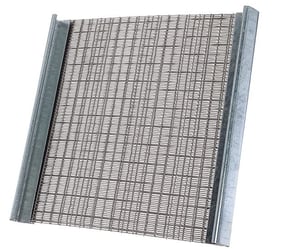
Standing for tonnage capacity, the thick wires of TON-CAP make it particularly useful when applied to high-capacity applications. This is because, with thicker wires, you can increase the throughput of material without the risk of premature wear.
Panel Dimension
Knowing what panel dimensions your equipment is designed to hold is key to optimal dewatering. Having a panel too large will cause slack throughout the panel, resulting in inconsistent screening and premature wear.
A standard woven wire mesh dewatering screen has a dimension of 48.5” (inside/outside the hooks) x 5’. Each screen will typically come in 5-foot increments.
While this is the standard dimension, they can be exceeded upon request.
Hook Type
The hooks of a woven wire mesh dewatering screen are multifunctional. They work to secure the screen in the vibrating screen machine while also ensuring the screen is drum-tight.
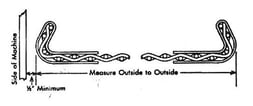
These hooks will often be constructed from a galvanized steel, with plastic inserts to prevent dissimilar metal corrosion. You do have the option to request other alloys, such as stainless steel, but this will increase the cost and lead time associated with the screen.
How Do I Pick the Right Dewatering Screen Specification?
For the most part, the specifications you should be using to design your dewatering screens should be established within your organization. But if you are confused by the set specifications or your organization has not yet set these specific standards, a reliable wire mesh supplier will be able to work with you to determine what is right for you.
Knowing the particle size range of the material that should be screened and retained is critical. Providing this information will better equip the mesh supplier to calculate the mesh opening size, weave type, and layer configuration you need to reach your goals.
Providing the make and model of the machine will also enable the supplier to spec out the dimensions of the dewatering screen panel. This will ensure the measurements of the screen with the hooked attached accommodate the particular vibrating screen machine you are working with.
NOTE: The length measurements of a dewatering screen can either reflect measurements taken within the clamps or outside the hooks. These measurements are key to keeping the mesh drum tight once installed in the machine.
Understand How Woven Wire Dewatering Screens Compares To Similar Solutions
Picking the right hook type, weave type, and dimension combination is critical to the success of any woven wire dewatering screen. Naturally, the combination that is right for you is dependent on the particle size range of your material and the vibrating screen machine you are using.
By now, you should have a general understanding of the capabilities of woven wire dewatering screens. But in order to feel confident in your investment, you must compare and contrast these capabilities to other dewatering screen solutions, such as flex-mat.
For over 150 years, W.S. Tyler has helped customers implement wire mesh screening solutions that deliver peace of mind. We strive to learn your process inside and out in an effort to resolve any doubts you may have about woven wire mesh.
To gain insight into how woven wire dewatering screens stack up against similar dewatering screens, read the following article:
About Ronnie Brown
Ronnie is the Content Writer for W.S. Tyler and has four years of experience as a professional writer. He strives to expand his knowledge on all things particle analysis and woven wire mesh to leverage his exceptional writing and graphic design skills, creating a one-of-a-kind experience for customers.

